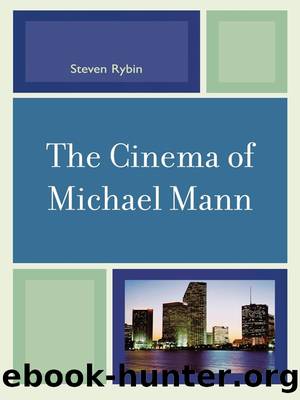The Cinema of Michael Mann by Steven Rybin

Author:Steven Rybin
Language: eng
Format: epub
ISBN: 9780739153031
Publisher: Lexington Books
Published: 2013-06-24T16:00:00+00:00
Mann first mentioned this story in a 1983 interview published shortly before the release of The Keep, stating that, while he was proud of Heat as a screenplay and wanted to produce it, he would never actually direct it himself. 4 Twelve years later Al Pacino and Robert De Niro were signed to star in the film, with Mann aboard as director. In many ways Heat builds upon Mann’s genre work in Thief in its echoes of the gangster and crime film. J. A. Lindstrom has suggested that “Heat is a film about work and its increasing personal costs . . . the film’s emphasis on the conflict between work and home—for both the criminals and the police—is a timely innovation in the gangster genre, drawing on actual trends in work during the 1990s.”5 Heat represents a certain kind of work that is not often displayed in Hollywood films: It portrays wealth (in the thieves’ designer homes and the upscale restaurants in which they dine) and then explores with precision how that wealth is accumulated (criminal activity) and how this accumulation indeed involves the collective efforts of individuals from the entire stratum of social classes. As both Lindstrom and genre scholar Steve Neale have suggested, this emphasis on the work of the upper class is the mark of a cycle of heist pictures released in the early 1990s, including King of New York (Abel Ferrara, 1990) and Sneakers (Robert Redford, 1993). These films are in contrast to a contemporaneous cycle of independent films about lower-class gangsters such as Reservoir Dogs (Quentin Tarantino, 1992) and Killing Zoe (Roger Avary, 1994).6 Heat’s criminals, in fact, can be viewed as a composite portrayal of both classes, for while De Niro and Val Kilmer’s characters are well-off, others in their gang, such as the African American driver played by Dennis Haysbert, become involved in criminal activity simply to make ends meet.
Lindstrom, in citing the difficulty a number of critics have had in finding meaning in the detail of Heat, has in his own criticism reduced the meaning of the film’s mise-en-scène to “slickness and an emphasis on style and personality,” but an exploration of the film’s genre by itself does not suffice to describe the specific stylistic approach Mann and his collaborators bring to the work.7 There is something about its style that is overwhelming, however, as some critics have suggested. Richard Combs has remarked that the film “gives off a blankness, an indeterminacy, that frustrates interpretation”;8 and Nick James has remarked that the difficulty in reading the style derives from its “fulsome ambivalence.”9
There exists no single key with which to unlock the meaning behind Heat’s exquisite visual style, but I suspect we can learn a great deal about the meanings and themes such style generates by considering the two directorial influences which mark its aesthetic more than any others: Stanley Kubrick and Dziga Vertov. Michael Mann has often expressed admiration for these filmmakers, naming Dr. Strangelove, or How I Learned to Stop Worrying
Download
This site does not store any files on its server. We only index and link to content provided by other sites. Please contact the content providers to delete copyright contents if any and email us, we'll remove relevant links or contents immediately.
Cecilia; Or, Memoirs of an Heiress — Volume 1 by Fanny Burney(31333)
Cecilia; Or, Memoirs of an Heiress — Volume 3 by Fanny Burney(30934)
Cecilia; Or, Memoirs of an Heiress — Volume 2 by Fanny Burney(30889)
The Great Music City by Andrea Baker(21313)
We're Going to Need More Wine by Gabrielle Union(18073)
Bombshells: Glamour Girls of a Lifetime by Sullivan Steve(13108)
Pimp by Iceberg Slim(12931)
All the Missing Girls by Megan Miranda(12748)
Fifty Shades Freed by E L James(12451)
Norse Mythology by Gaiman Neil(11883)
Talking to Strangers by Malcolm Gladwell(11878)
Crazy Rich Asians by Kevin Kwan(8349)
Mindhunter: Inside the FBI's Elite Serial Crime Unit by John E. Douglas & Mark Olshaker(7834)
The Lost Art of Listening by Michael P. Nichols(6474)
Enlightenment Now: The Case for Reason, Science, Humanism, and Progress by Steven Pinker(6405)
Bad Blood by John Carreyrou(5769)
The Four Agreements by Don Miguel Ruiz(5511)
Weapons of Math Destruction by Cathy O'Neil(5037)
We Need to Talk by Celeste Headlee(4869)
